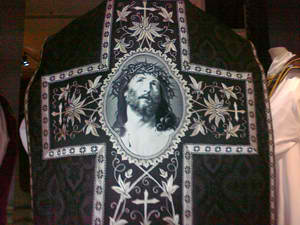
THE ST. GALLEN TEXTILE MUSEUM
(HERRLICHKEITEN-Textile Kirchenschätze aus St. Gallen)
For centuries, it is usual to associate splendor and sumptuousness especially with the Catholic Church. Fabrics of many colors and decorated with the objects by the goldsmith artisans and glassmakers attract admiration. The liturgical celebrations are lavish staging of the art work, a perfect synthesis of music, lyrics and decorations.
The production of the garments is subject to strict rules, according to which colors, materials and shapes mark the various stages of the liturgical year, or ecclesiastical feasts.
For ecclesiastical garments only the most precious materials were and are used. Some items had to be made exclusively of silk or linen. The embroidery with silk threads, gold and silver threads, pearls and sequins decorates the clothes of the prelates and clergy, and embellishes the fabric for the altar, the accessories for the sacred liturgy, the furniture, the interior of the church, as well as the banners in processions or canopies.
The use of the ecclesiastical dress during the liturgical year is governed by strict rules. The Canon of the colors of the Christian church dates back to antiquity and the possible coloring techniques for that time. The first color order in the sacred liturgy is due to Pope Innocent III in 1200, sanctioned in 1570 in the Roman Missal.
The new Missal of 1970 reflects these rules that are still valid today:
White (with gold and silver) is a sign of purity, innocence, light and joy, is used during the Christmas and Easter time, feasts of the Lord, the Virgin Mary and the saints that are not martyrs.
Red is the color of blood and fire, it is used at Pentecost, during the Feasts of the Apostles and Martyrs, on Palm Sunday and Good Friday.
Purple is a symbol of passage and transformation, it is used in Advent, Lent and in the liturgy of the dead.
Pink indicates the waiting, and it is used on the third Sunday of Advent and the fourth Sunday of Lent.
Black indicates grief and death, but also the transition from earthly life to eternal life, and it is used in the dead celebration.
Green is a symbol of hope and life, and it is used in ordinary time.
Even the cut of the liturgical garments has ancient roots, when the dress was used to highlight the clergy than the mass of believers, making tangible the power and wealth of the Church. The appearance of liturgical garments has changed a little throughout the centuries, while patterns of the used fabrics and the type of decoration have adapted to the spirit of the time.
Originally garments were made by professional embroiderers and nunneries, and about 150 years are also made by specialized companies. At the end of the 19th century, many embroidery companies of St. Gallen produced ecclesiastical fabrics. They worked according to tradition, adapting clothes to the taste of time and making them modern. The Huber-Meyenberger Kirchberg has made garments in large quantities till 1905. The clothing company of the most successful garments is Fraefel of St. Gallen, who made garments from 1883 to 1965. 150 employees, hand embroiderers from all eastern Switzerland and nuns worked for this company. The export of the products in the U.S. and Germany has played a leading role until the end of the 20s.








